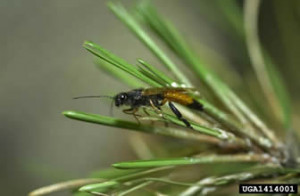A non-native woodwasp, Sirex noctilio, was detected in New York (NY) in 2005 and likely entered a port via solid wood packing material in cargo. This insect is native to Europe and Asia, but has now been introduced into every continent, and has the potential to kill many species of pines including several of our native species. In Georgia, species of pines could be impacted including several of tremendous commercial importance: Loblolly (Pinus taeda), Shortleaf (Pinus echinata), and Slash (Pinus elliottii).

This is a large insect (1 – 1.5 inches in length) that is a strong flyer capable of traveling almost 50 miles in one season, and now covers a good portion of NY and has migrated southward into Pennsylvania, and northward into Canada. Trapping surveys are taking place in several southeastern states, including Georgia, but no Sirex noctilio has been detected to date.
Part of their life cycle involves creating egg niches and laying eggs in trees, and they also inject a symbiotic fungus and toxic mucus into the tree. The larvae feed upon the fungus, but the mucus spreads within the water conductive tissue of the tree and clogs this pathway. When a critical level of this vascular tissue can no longer function, moisture stress occurs in the tree and death soon follows. Furthermore, their larvae tunnel through the wood as the feed upon the fungus (not the wood), and these large holes can mechanically disrupt the water conductive tissue also.
We have several species of native woodwasps in the southeastern U.S., including 2 species within the Sirex genus, but these other species do not kill the host trees. In other parts of the world, it has been observed that weakened, stressed stands (such as overstocked plantations) have been more vulnerable to Sirex noctilio than thinned, vigorous, healthy stands. Furthermore, a biological control agent (nematode that sterilizes the adults), was developed in Australia and successfully introduced into the environment and this has helped suppress outbreaks. This nematode has been tested in NY (2006), and may be introduced in quantity at some point in the future in the United States.
About half of Georgia’s 24.7 million acre forest contains a pine component that could be at risk from this pest.
We are happy to assist with any questions or concerns you may have. If you can’t find something you are looking for, please let us know, and we will be glad to help.
